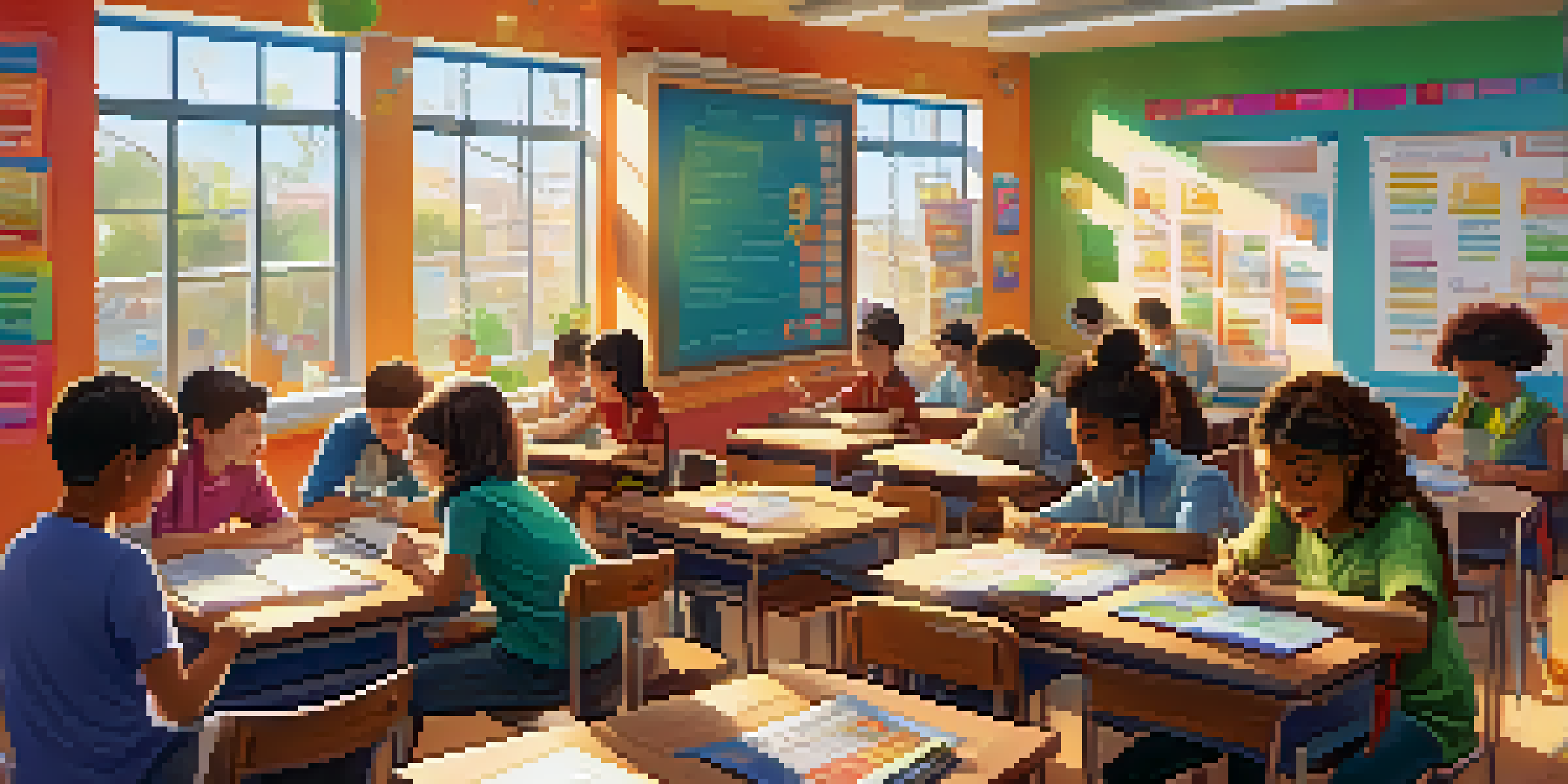Gamification and Its Effects on Classroom Management Techniques

Understanding Gamification in Education
Gamification is the process of incorporating game-like elements into non-game contexts, like education. In the classroom, this means using rewards, challenges, and competition to engage students more deeply. For example, teachers might implement point systems or badges to recognize student achievements. By turning learning into a more interactive experience, gamification can motivate students who might otherwise be disengaged.
The only way to win is to learn faster than anyone else.
At its core, gamification taps into the natural human desire for achievement and recognition. When students feel like they are part of a game, they often put in more effort and take more risks in their learning. This approach is particularly effective in managing classroom dynamics, as it encourages collaboration and healthy competition among peers. Teachers can create an environment where students are excited about coming to class.
However, it’s essential to strike a balance. While gamification can enhance engagement, over-reliance on game mechanics can lead to a lack of intrinsic motivation. This means students might focus solely on rewards rather than the learning process itself. Therefore, integrating gamification thoughtfully is crucial to ensure it supports overall educational goals.
Benefits of Gamification for Classroom Management
One of the primary benefits of gamification is its impact on student behavior. By introducing game-like elements, teachers can create a structured environment where students know what is expected of them. For instance, a classroom might use a leaderboard to track student performance, encouraging positive behavior while fostering a sense of community. This can lead to reduced disruptions and a more focused classroom atmosphere.

Additionally, gamification provides immediate feedback, which is vital for student growth. When students receive instant rewards or recognition for their efforts, it reinforces positive behavior and encourages them to continue striving for success. This ongoing feedback loop can be incredibly motivating, making students feel valued and engaged in their learning journey.
Gamification Boosts Student Engagement
Incorporating game-like elements in education motivates students by making learning interactive and rewarding.
Moreover, gamification can help teachers identify areas where students may struggle. By analyzing performance in a game-like setting, educators can pinpoint which concepts need reinforcement. This data-driven approach allows teachers to tailor their classroom management techniques and instructional strategies to better meet the needs of their students.
Gamification Strategies to Implement in Classrooms
There are various strategies for integrating gamification into classroom management. One effective method is to create a point system where students earn points for completing assignments, participating in discussions, or helping peers. These points can then lead to rewards, such as extra credit or free time, fostering a sense of accomplishment. This approach not only motivates students but also encourages teamwork and collaboration.
Games are the most elevated form of investigation.
Another powerful strategy is to use digital platforms that offer gamified learning experiences. Tools like Kahoot! or Quizizz allow teachers to create interactive quizzes that make learning fun. These platforms often include elements like leaderboards and challenges, making the learning process more dynamic and engaging. Such tools can also be a great way to assess student understanding in real-time.
Finally, consider incorporating storytelling elements into lessons. By framing lessons as quests or adventures, teachers can capture students' imaginations. This narrative approach can enhance students' emotional connection to the material, making it more memorable. When students see themselves as characters in a story, they are more likely to stay engaged and take ownership of their learning.
Challenges of Gamification in Classroom Management
While gamification offers numerous benefits, it also presents challenges that educators must navigate. One significant concern is the potential for competition to overshadow collaboration. If not managed carefully, a competitive atmosphere can create anxiety among students and discourage those who may not perform as well. Teachers need to foster a culture where both individual and group achievements are celebrated.
Moreover, the effectiveness of gamification can vary significantly among students. Some learners thrive in competitive environments, while others may feel overwhelmed or alienated. It’s essential for educators to be mindful of different learning styles and adjust their gamification strategies accordingly. Ensuring that all students feel included and valued is key to successful implementation.
Challenges of Gamification
While gamification can enhance learning, it risks fostering competition over collaboration and encourages external rewards over intrinsic motivation.
Another challenge is the risk of students becoming overly focused on external rewards. If students prioritize earning points or badges above the learning itself, it can lead to superficial engagement. To counter this, educators should emphasize the importance of intrinsic motivation and the joy of learning. Balancing external rewards with meaningful learning experiences is crucial for long-term success.
Real-Life Examples of Gamification in Classrooms
Many educators have successfully implemented gamification in their classrooms with impressive results. For instance, a high school teacher introduced a quest-based learning system where students completed assignments to earn experience points. Over time, students formed teams to tackle projects, promoting collaboration and camaraderie. This approach not only improved engagement but also led to higher academic performance.
Another example is a middle school that utilized a classroom economy. Students earned 'classroom dollars' for positive behaviors and completing tasks, which they could then use to purchase privileges or items. This system encouraged students to take ownership of their actions and created a sense of accountability within the classroom. Students felt empowered to make choices and understand the consequences of their behavior.
Lastly, a local elementary school used a digital platform for spelling tests, transforming them into an interactive game. Students could compete against each other in a fun, low-pressure environment, which significantly boosted their interest in vocabulary. The excitement of the game made learning feel less like a chore and more like a fun activity, showcasing how gamification can transform traditional educational practices.
The Role of Technology in Gamification
Technology plays a pivotal role in the successful implementation of gamification in education. With the rise of digital tools, teachers can easily create engaging experiences that blend learning with play. For instance, apps and software designed for educational purposes often include gamified elements, such as levels and badges, making it easier for teachers to track student progress and foster motivation.
Furthermore, technology enables personalized learning experiences, allowing students to learn at their own pace. Through gamification, educators can set different challenges tailored to individual student needs. This flexibility ensures that all learners are challenged appropriately, helping them to remain engaged and motivated. The use of technology can significantly enhance the effectiveness of gamification strategies.
Technology Enhances Gamification
Digital tools and platforms play a crucial role in implementing gamification effectively, allowing for personalized and engaging learning experiences.
However, it's essential for educators to ensure that technology is used thoughtfully. Simply adding games to the curriculum without a clear educational purpose won't yield the desired results. Teachers should carefully select tools that align with their learning objectives and actively involve students in the learning process. This thoughtful integration of technology will maximize the benefits of gamification.
Future of Gamification in Education
As education continues to evolve, the role of gamification is likely to expand. With advancements in technology and a growing understanding of student engagement, educators will find new and innovative ways to incorporate gamified elements into their teaching. For instance, virtual reality and augmented reality could offer immersive learning experiences that make education even more interactive and enjoyable.
Moreover, research into gamification's effectiveness will continue to shape how it's implemented in classrooms. Educators will be able to leverage data-driven insights to refine their strategies, ensuring they meet the diverse needs of their students. This ongoing evolution will help gamification to remain relevant and effective in fostering student engagement and improving classroom management.

Ultimately, the future of gamification in education holds great promise. By embracing this approach, teachers can create dynamic learning environments that inspire and motivate students to reach their full potential. As we look ahead, it's clear that gamification will play an integral role in transforming how we teach and learn.